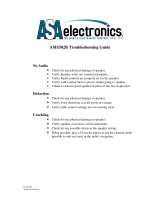PS Engineering
Radio Adapter (12100) Series Interface
Installation Manual
200-002-0002 2-3 Rev. 6, Oct. 2-18
Refer to FAA Advisory Circular 43.13-2A for more information. Failure to use correct
techniques may result in improper operation, electrical noise or unit failure. Damage
caused by improper installation will void the PS Engineering warranty.
2.4.1 Noise
Due to the variety and the high power of radio equipment often found in today's general
aviation aircraft, there is a potential for both radiated and conducted noise interference.
Ground loop noise occurs when there are two or more ground paths for the same signal
(i.e., airframe and ground return wire). Large cyclic loads such as strobes, inverters, etc.,
can inject noise signals onto the airframe that are detected by the audio system. Follow
the wiring diagram very carefully to help ensure a minimum of ground loop potential.
Use only Mil Spec shielded wires (MIL-C-27500, or better).
Do not run microphone audio and headphone audio in the same, shielded jacket, use sep-
arate shielded pair. Do not use the shield as a conductor, (audio low, etc) as this will cre-
ate potential noise sources.
Radiated signals can be a factor when low level microphone signals are "bundled" with
current carrying power wires. Keep these cables physically separated.
2.4.2 Power
The Radio Adapter (12100) is compatible with both 13.8 and 28 Volt DC systems. A one
(1) Amp circuit breaker is required. Fourteen-volt aircraft supply power through Pin 2,
28VDC aircraft through pin 1. Pins 14 and 15 are aircraft ground. Keep ground wires as
short as possible.
2.4.3 Interface to aircraft audio system
The aircraft-audio output from the Radio Adapter is pin 4 with respect to (WRT) pin 17.
This is a standard 500 audio output, similar to a VHF Communications transceiver.
The microphone audio input is pin 3, WRT 16. This is an aviation-standard dynamic mic
input, similar to a VHF Communications transceiver input. The PTT input on pin 7 is
ground-seeking, like an aviation microphone.
2.4.4 Interface to non-aviation transceiver
The Radio Adapter audio input is transformer-coupled, pin 6, WRT pin 19. This can be
configured for either a 150 or 8 speaker output from the transceiver.
The Microphone output from the Radio Adapter to the transceiver mic input is pin 5
WRT 18. This can be configured for either an 8 or 150 mic, which is amplified or
non-amplified, or 150 , passed directly to the radio. The ground can be either audio
low, or airframe ground referenced.
Many transceivers with hand microphones do not have a mic bias source, necessary for
an aviation headset. Install the jumper at JP1 across pins 1 and 2 to generate a mic bias
source, which will be connected to the aircraft microphone when the transceiver is select-
ed for transmit.
















